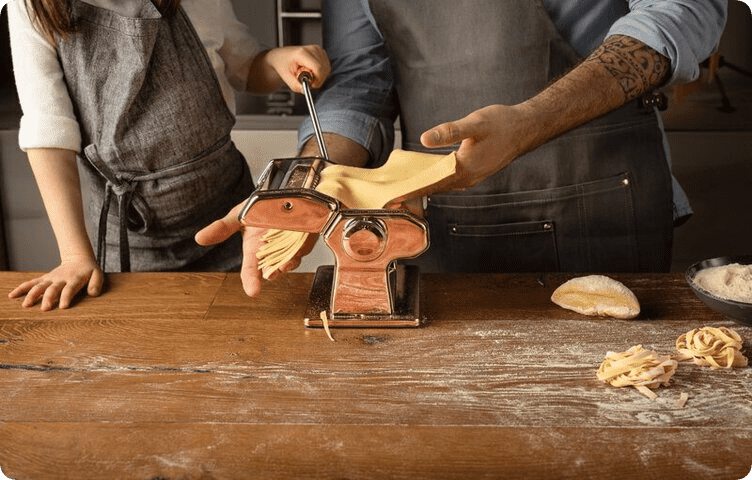Today, a huge number of different pasta products are sold on the shelves of grocery stores: from Russian-made noodles to Italian pasta made from premium flour. However, no store-bought product compares to homemade pasta.
The ideal Italian pasta, worthy of the praise of Italian chefs, can only be prepared using professional equipment - a pasta machine . A device of this format will not only help you quickly cut noodles. A good device will give you the opportunity to experiment with the shapes and flavors of pasta.
It will also allow:
- Roll out the noodle dough evenly and thinly;
- cut the pasta into equal strips;
- prepare a paste that will be many times healthier than a store-bought product.
Principle of operation
A classic pasta cutter consists of two metal rollers housed in a rectangular body. The distance between the rollers is adjusted with a special handle. The thickness of the future layer for pasta depends on the size of this distance. The noodle cutter works as follows.
The pasta dough is first fed into the machine and then passed through rotating rollers where it takes on a stretched appearance. The finished layer is sent to the cutting compartment. There, special attachments divide the dough into pieces. Each attachment for the device has its own shape or involves molding products into a silhouette (for example, into bows).
Types of Pasta Making Machines
Tools for making noodles are divided into:
- electromechanical devices - electrically driven devices quickly cut the dough into even strips; they are capable of providing a constant flow of pasta for 20–30 dishes;
- and manual machines - devices of this format have more limited capabilities.
Mechanical devices are driven by hand drive. In order for the rollers that thin and level the dough to start rotating, you need to twist the handle of the machine.

Electromechanical models minimize physical labor. Their operation is entirely dependent on connection to the electrical network. But such devices are more expensive than primitive hand-held devices. Every detail in the design of such machines is thoroughly thought out: from high-quality materials to reliable electronics. Using such electromechanical units, it is possible to produce homemade noodles with a width of 2 to 6.5 mm.
Advantages
Pasta machines:
- capable of making pasta of various types;
- easy to use;
- save time on preparing the product.
Both manual and electromechanical pasta cutting machines make it easy to create classic spaghetti, fettuccine, tagliatelle, fusilla and other types of pasta.
Basic recommendations when choosing
When choosing a noodle cutter, focus more on technical characteristics.
Device performance. For a small point, a manual noodle cutting machine is suitable. For an Italian restaurant with high traffic, it is better to purchase a device with a capacity of at least 12 kg/hour, operating in automatic mode.
Material. An all-steel device is less susceptible to wear. It’s even better if the product has a chrome finish. This coating not only protects the machine body from corrosion. It makes washing and storing the machine easier. Individual elements (for example, the tip of the handle) can be made of plastic or natural wood.
Device size. For a small working area, it is better to choose a device with a smaller profile. For a large enterprise, it is worth buying floor-mounted dough sheeters.
Product assembly. In the selected device, all parts must be securely fastened. Any defect during assembly can reduce the performance of the installation and cause breakdown. It's better to take a dismountable car. The removable roller for cutting noodles is easier to clean from dough residues.
Additional fastenings. It is better to take a model equipped with a lock or clamp for working on slippery surfaces. The special mount makes the device more stable.
















































/https%3A%2F%2Fcomplexbar.com%2Fimages%2Fblog%2F131%2Fpasta-mashina-article-transformed-ver2.jpeg)
/https%3A%2F%2Fcomplexbar.com%2Fimages%2Fblog%2F245%2Fskov_glavn.jpeg)
/https%3A%2F%2Fcomplexbar.com%2Fimages%2Fblog%2F245%2Fhaiboli.jpg)
/https%3A%2F%2Fcomplexbar.com%2Fimages%2Fblog%2F245%2Fvilki-na-stole-752x480.jpeg)
/https%3A%2F%2Fcomplexbar.com%2Fimages%2Fblog%2F246%2F2024-04-09_17.22.54.jpg)
/https%3A%2F%2Fcomplexbar.com%2Fimages%2Fblog%2F246%2F2024-04-09_17.22.47.jpg)
/https%3A%2F%2Fcomplexbar.com%2Fimages%2Fblog%2F246%2FCODE_anons_foamydrops_752%D1%85480_eng.jpg)
/https%3A%2F%2Fcomplexbar.com%2Fimages%2Fblog%2F246%2FAlina_752%D1%85480_eng.jpg)
/https%3A%2F%2Fcomplexbar.com%2Fimages%2Fblog%2F246%2F2024-04-09_17.23.22.jpg)
/https%3A%2F%2Fcomplexbar.com%2Fimages%2Fblog%2F246%2F2024-04-09_17.23.28.jpg)
/https%3A%2F%2Fcomplexbar.com%2Fimages%2Fblog%2F246%2F2024-04-09_17.23.35.jpg)
/https%3A%2F%2Fcomplexbar.com%2Fimages%2Fblog%2F246%2Fdrinksome_752%D1%85480_eng.jpg)
/https%3A%2F%2Fcomplexbar.com%2Fimages%2Fblog%2F246%2Fnude_752%D1%85480_eng.jpg)
/https%3A%2F%2Fcomplexbar.com%2Fimages%2Fblog%2F246%2F752%D1%85480_eng__1_.jpg)
/https%3A%2F%2Fcomplexbar.com%2Fimages%2Fblog%2F246%2F752%D1%85480_eng.jpg)
/https%3A%2F%2Fcomplexbar.com%2Fimages%2Fblog%2F246%2FStudioRaw_752%D1%85480_eng.jpg)
/https%3A%2F%2Fcomplexbar.com%2Fimages%2Fblog%2F246%2FDoppio_tea_752%D1%85480_eng.jpg)
/https%3A%2F%2Fcomplexbar.com%2Fimages%2Fblog%2F246%2FTognana_Stars_Stripes_752%D1%85480_eng.jpg)
/https%3A%2F%2Fcomplexbar.com%2Fimages%2Fblog%2F246%2FRona_752%D1%85480_eng.jpg)
/https%3A%2F%2Fcomplexbar.com%2Fimages%2Fblog%2F246%2FDoppio_vending_752%D1%85480_eng.jpg)
/https%3A%2F%2Fcomplexbar.com%2Fimages%2Fblog%2F246%2FEssence_sukhie_smesi_752%D1%85480_eng.jpg)
/https%3A%2F%2Fcomplexbar.com%2Fimages%2Fblog%2F246%2FODK_sukhie_smesi752%D1%85480_eng.jpg)
/https%3A%2F%2Fcomplexbar.com%2Fimages%2Fblog%2F246%2Funiforma-barmena.jpg)
/https%3A%2F%2Fcomplexbar.com%2Fimages%2Fblog%2F246%2Fkak-nanyat-barmena.jpg)
/https%3A%2F%2Fcomplexbar.com%2Fimages%2Fblog%2F246%2Fsirop_scale_2400.jpeg)
/https%3A%2F%2Fcomplexbar.com%2Fimages%2Fblog%2F246%2FPeugeot_Anons_Paris_U%27Select_Line_Daman_752%D1%85480_eng.jpg)
/https%3A%2F%2Fcomplexbar.com%2Fimages%2Fblog%2F246%2Fkofe-vostochniy.jpg)
/https%3A%2F%2Fcomplexbar.com%2Fimages%2Fblog%2F246%2FMadler.jpg)
/https%3A%2F%2Fcomplexbar.com%2Fimages%2Fblog%2F246%2Fprofbartender_glavn.jpeg)